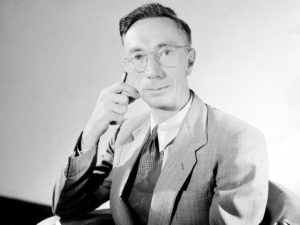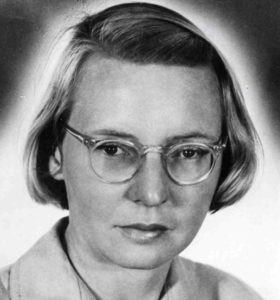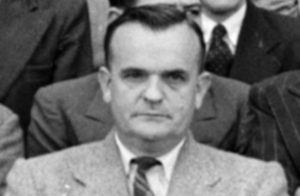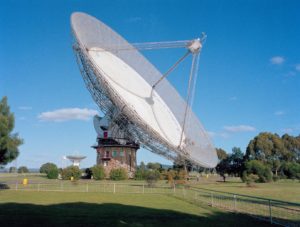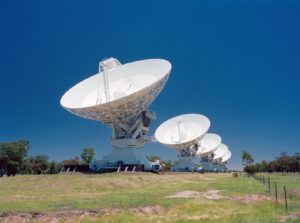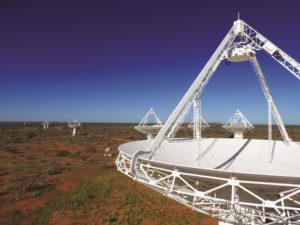Radar and the birth of radio astronomy in Australia at Collaroy Plateau
The first successful radio astronomy observation in Australia took place on 3 October 1945. Scientists from the Council for Scientific and Industrial Research (CSIR, later CSIRO), supported by the Royal Australian Air Force (RAAF), began a program to observe radio waves emitted from the Sun using equipment which had been installed at the Collaroy Plateau air and sea defence radar station during WWII. The detection on 3 October of intense radio emission coming from the Sun marked the birth of radio astronomy in Australia.
The radar station at Collaroy Plateau
Secret research into the development of radar for defence purposes was first shared with Australia by the British in 1939 at the outset of WWII. Provided with this critical information, the Australian Government allocated 80,000 pounds for the CSIR to establish a radar research facility that would develop radar defence systems for Australia.
The CSIR Division of Radiophysics was formed in 1940 to develop this top-secret technology. For security purposes the Radiophysics Laboratory was co-located with the CSIR National Standards Laboratory in what is now the Madsen building in the grounds of the University of Sydney. The first CSIR staff moved into the new facility in March 1940. By the end of the war, the Division employed over 60 scientists and had developed more than 20 different types of radar systems. The CSIR became the Commonwealth Science and Industrial Research Organisation (CSIRO) in 1949.
Wartime shortages and its isolation meant that the Australians had to develop much of the technology themselves rather than just ordering equipment from the UK or US. In many cases, the radar systems designed by the Division of Radiophysics were manufactured by the NSW Government Railways workshops.
How does radar work?
Radar works either by sending out a pulse of radio waves and then detecting the signals that bounce back from objects (for example ships, or aircraft) that are in the path of the wave (Figure 1), or by sending out a continuous wave signal and monitoring the doppler shifts of the returned signals. In pulse radar, the time taken to send and receive a reflected signal is used to determine the distance to the object. Radar can operate during day or night, through cloud, fog or rain.
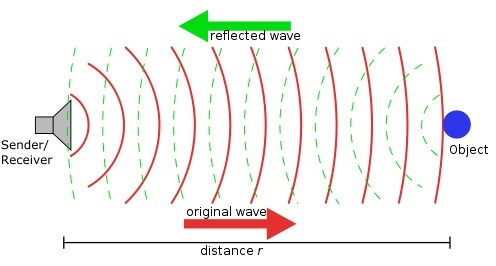
Figure 1 – Radar works by sending out a pulse of radio waves and then listening for the signals that are reflected from objects (i.e. ships or aircraft) in the path of the wave.
In 1940 Australia was concerned about enemy attacks from the sea. ‘Shore Defence’ radar systems were installed along the coast (in all states) to warn of approaching ships. Following the Japanese air raid on Pearl Harbour on 7 December 1941, it was realised that Australia would also be vulnerable to air attack, so an urgent program to develop air warning radar was established. Australia’s vulnerability to air attack was demonstrated by the Japanese air raid on Darwin on 19 February 1942. The Radiophysics team quickly developed a modified prototype version based of the existing shore defence radar at Dover Heights. From this prototype, many variants were produced culminating in the highly successful Australian designed Light Weight Air Warning radar (LW/AW). This was not only light-weight to allow air transportation, but also was designed so that its structure and electronics would function effectively in the humid tropical environment of the South-West Pacific Theatre of War.
In late April 1942, RAAF Radar Station (No. 101/54) was established at Collaroy Plateau to track the movement of aircraft and shipping approaching Sydney. The Plateau is located approximately 10 kilometres north of the North Head entrance to Sydney Harbour and 60 kilometres east of the Blue Mountains. It is at a height of 110 m above sea level.
Several different types of radar were used at Collaroy, including a version of the British designed COL (Chain Overseas Low [flying]) Mk.V (Figure 2). The station also served as a test site for new radar equipment being developed by the CSIR Division of Radiophysics. The Collaroy Plateau station was one of the most critical stations for air warning for Sydney’s northern approaches. The site was officially decommissioned in February 1946 following the end of hostilities, and the equipment was ultimately removed from the site.

Figure 2 – A COL (Chain Overseas Low [flying]) Mk.V 200 MHz radar at Collaroy Plateau in early 1946. This view is looking toward the east with the control room in the foreground. This radar was designed in Britain with the aerial and its tower built by the NSW Government railways. (Photo courtesy of Deidre and Jim Thorncraft, reproduced from Ted Dellit’s book The Royal Australian Air Force on Collaroy Plateau in the Second World War, 2000).

Figure 3 – Aerial views of Collaroy Plateau Park in 1943 and today. The area occupied by the radar station is now occupied by the Northern Beaches Council’s community park, Plateau Park. The “yellow” boundary on the 1943 image shows the approximate boundary of the park today. The radar shown in Figure 2 is located toward the centre of the 1943 image (https://maps.six.nsw.gov.au/)
The first radio astronomy observation in Australia
As WWII drew to a close, the CSIR redirected the highly secretive Division of Radiophysics from wartime activities to civil research. One of the new fields considered was an investigation of the sources of unknown and nuisance radio ‘noise’ detected with radar by several countries during the war.
In 1945, the Division received reports from the US, UK and New Zealand which described high levels of ‘noise’ or ‘interference’ in radar observations that were apparently caused by the Sun. Of particular interest was the report received from Dr Elizabeth Alexander, the Head of the Operational Research Section of the Radio Development Laboratory in New Zealand. In March 1945 she arranged for the Royal New Zealand Air Force at Norfolk Island to observe the Sun using radar receiver equipment and reported the reception of strong signals over a period of several days. These reports inspired the Division to begin a program of solar observations at radio wavelengths using radar equipment developed for defence.
The first successful experiment in Australia in the new field that would become radio astronomy occurred at sunrise on 3 October 1945 at Collaroy Plateau. RAAF radar operators, on instruction from CSIR scientists led by the Group’s Head, Dr Joseph L Pawsey, used the 200 MHz COL RAAF radar shown in Figure 2 for observations. The radar aerial was mounted vertically and was rotated around a vertical axis to observe the Sun at sunrise and rotated to face the west to observe sunset. In this reception-only mode, the radar system was set to receive but not transmit signals. For the solar observations, the radar aerial was rotated to ‘sweep’ over 40 degrees from one side of the Sun to the other, and the receiver power output levels were recorded every two degrees of rotation.
On 3 October 1945, sunrise at Collaroy Plateau was at 05:30 am. The RAAF operators captured the first Australian radio-frequency detection of the Sun and the first Australian radio astronomy observation. Ruby Payne-Scott ( Figure 5), who worked for Joseph Pawsey, recorded this description in her 1945 internal laboratory report:
At 0531 an increase in noise level of about 27 per cent over the general level was observed at a bearing of about 94 degrees. In successive sweeps this increase in noise became more marked, until at 0540 the noise power on a bearing of 93 degrees was four and a half times the normal noise power. Over the next twenty minutes it declined, rose again to a smaller peak at 0610 and then declined again, the effect being just detectable at 0730.
Solar research at Collaroy Heights
The CSIR solar research team, led by Dr Joseph Pawsey ( Figure 4) continued to monitor the Sun at Collaroy Plateau from October 1945 until March 1946 ( Figure 7). Most of the readings were recorded for the team by the RAAF staff working at the site. Daily observations were taken for about an hour at sunrise, and again at sunset with the aerial directed west towards the Blue Mountains. This program, described by Payne-Scott in her 1945 internal report and by Pawsey, Payne-Scott and McCready ( Figure 6) in 1946 in a letter to the highly regarded scientific journal, Nature, was highly successful. The three CSIR scientists discovered some surprising characteristics of the Sun at the radio frequency of 200 MHz (a wavelength of 1.5 m), they include:
- The radio emission showed fluctuations in measured power output with significant variations from day to day over an order of magnitude. By comparing the radio data with solar data provided from Mt Stromlo Solar Physics Observatory (Canberra), they found that the fluctuations were strongly correlated with sunspots on the Sun’s surface ( Figure 8). Pawsey, Payne-Scott and McCready (1946) wrote that
It is apparent that the peaks of the 1.5-metre radiation coincide with peaks of the sunspot area curve and with the passage of large sunspot groups across the median.
- Besides the intense variable sources of radiation associated with sunspots, the team also found a base level of thermal radiation some 100 times higher than expected. The visible surface of the Sun (the photosphere) has a temperature of about 6000 K. In comparison, the radio data indicated ‘effective’ temperatures as high as 10 million K, with a base level of approximately 1 million K. As early as 1937, using eclipse observations, it had been suggested that the Sun’s outer atmosphere (the Corona) might have such a high temperature despite the much lower surface temperature. The theorist David F. Martyn predicted that the Corona would produce thermal radiation observable at radio frequencies at these temperatures. Martyn’s predication, and Pawsey’s observations confirming the theory, appeared together in Nature on 2 November 1946.
As well as the solar work, the CSIR group briefly used the radar at Collaroy Plateau concurrently with radar antennas at an Army radar station at North Head, Sydney to survey regions of the sky. They were able to detect an enhanced level of diffuse radio emission coming from our Galaxy, particularly as the centre of our Milky Way galaxy rose above the eastern horizon. This very extended emission from the plane of our Galaxy was discovered by the American, Karl Jansky in 1932.

Figure 7 – Plots of Collaroy data at 200 MHz from October 1945 – March 1946. The top diagram is a hand-drawn plot from Pawsey (1946) that includes measurements from the first day of observations on 3 October 1945. The first point on the top-left graph on 3 October 1945 records the first radio astronomy observation (hand-drawn image courtesy of Goss/Ekers Collection). As this original diagram is very faint, reconstructed plots are shown below. The two time-series plots show the maximum strength of the solar emission measured from observations taken at sunrise between October 1945 and March 1946. The vertical axis shows the detected radio power in decibels, where a level of 0 dB, corresponds to approximately the total flux density of the quiet Sun at 200 MHz. The measured output receiver power levels varied by up to 10 dB. The bottom histogram shows the number of observations for the observed range of power levels in 2 db steps.
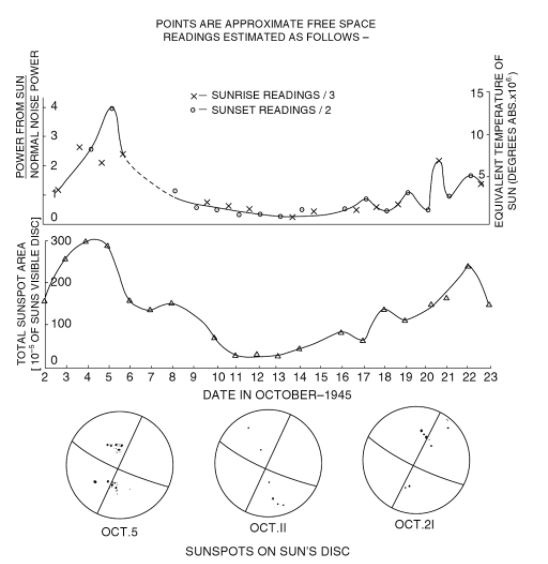
Figure 8 – Diagrams showing the radio power received from the Sun as measured at Collaroy Plateau (top plot). The level correlates with the number of sunspots visible on the Sun’s surface (middle plot). When there is a large number of spots covering a large area, the radio emission is stronger. The bottom diagram shows the position of sunspots on the Sun’s surface as viewed from Earth. These spots move postion as the Sun rotates. This diagram appeared in the scientific journal Nature in 1946 and was submitted on 23 October 1945, the same day as the last measurement on the graph. In the top plot, the scale is shown as a noise power (left) and as the ‘equivalent’ temperature for a blackbody source of radiation. The equivalent temperature of the solar radio emission at 200 MHz was estimated to fluctuate between approximately one million and 12 million degrees.
Following these initial successes at Collaroy Plateau, the team moved to an Army radar station at Dover Heights and a series of other field stations located around Sydney.
Radio astronomy in Australia
The early solar radio results from Collaroy Plateau were the start of solar radio astronomy in Australia. Pawsey and his team at the CSIR Division of Radiophysics went on to develop new instruments and techniques at Dover Heights and other field stations around Sydney. At Dover Heights, discoveries of radio waves from nebulae and distant galaxies helped establish Australia’s reputation as a world leader in the emerging field of radio astronomy.
CSIRO has continued to develop world-class facilities used by astronomers from around the world. In 2020 the radio astronomy telescopes, collectively known as the Australia Telescope National Facility, include the Parkes radio telescope ( Figure 9), the Australia Telescope Compact Array ( Figure 10) and the Australian SKA Pathfinder (ASKAP) ( Figure 11). Together with many discoveries in astronomy, the techniques and technologies developed in Australia have led to developments in areas as diverse as fast Wi-Fi and medical imaging.
From the humble beginnings at Collaroy Plateau, a whole new understanding of the Sun, our Galaxy, and the distant Universe emerged.
The Collaroy Plateau site is of historical significance as one of the first radar stations installed to protect Sydney during WWII, and as the birthplace of radio astronomy in Australia.
Figure 10 – The Australia Telescope Compact Array, located near Narrabri in northern New South Wales, is an array of six 22-metre diameter telescopes used for radio astronomy. The array opened in 1988 as a Bicentenary project and is part of the Australia Telescope National Facility (CSIRO Radio Astronomy Image Archive).
Figure 11 – CSIRO’s Australian SKA Pathfinder (ASKAP) radio telescope situated about 800 km north of Perth, at the Murchison Radio-astronomy Observatory in Western Australia. ASKAP is a synthesis array consisting of 36 dish antennas, each 12m in diameter, spread out in two dimensions with baselines up to 6km. (Ant Schinckel/CSIRO).
Sources
- Who were they? The Royal Australian Air Force on Collaroy Plateau in the Second World War, a history by Ted Dellit (https://catalogue.nla.gov.au/Record/484317). Dillet (1923-2007) was born in Caboolture (QLD) and joined the RAAF in 1942 and trained as a Radar Mechanic. He served in the RAAF until October 1944 with the rank of corporal. After leaving the service, he worked for commercial organisations and obtained a Batchelor of Commerce and Associate in Accountancy in 1949. He lived in the Collaroy/Dee Why area from 1961. He was an active member of the Radar Branch of the RAAF Association (NSW).
- CSIRO Radio Astronomy Image Archive. (https://www.atnf.csiro.au/ImageArchive/index.html).
- Goss WM, McGee RX, 2010, Under the Radar: The First Women Radio Astronomer, Ruby Payne-Scott, Springer Series: Astronomy and Space Science Library, Butler Burton (ed).
- Pawsey JL, Payne-Scott, R, McCready, LL, 1946, Nature, 157, 158.
- Pawsey JL 1946, Nature, 158, 633.
- Payne-Scott R, Solar and Cosmic Radio Frequency Radiation; Survey of Knowledge available and Measurements taken at Radiophysics Laboratory to 1st December 1945, CSIRO report SRP 501/27.
- Sullivan WT III, 2009, Cosmic Noise: A History of Early Radio Astronomy, Cambridge University Press.
- Orchiston W, 2005, Dr Elizabeth Alexander: First Female Radio Astronomer. In: Orchiston W. (eds) The New Astronomy: Opening the Electromagnetic Window and Expanding Our View of Planet Earth. Astrophysics and Space Science Library, vol 334. Springer, Dordrecht.
- Alexander FES, 1945, Report on the investigation of the “Norfolk Island Effect”. DSIR, Radio Development Laboratory, Report dated 1 August 1945 (R.D. 1/518).

